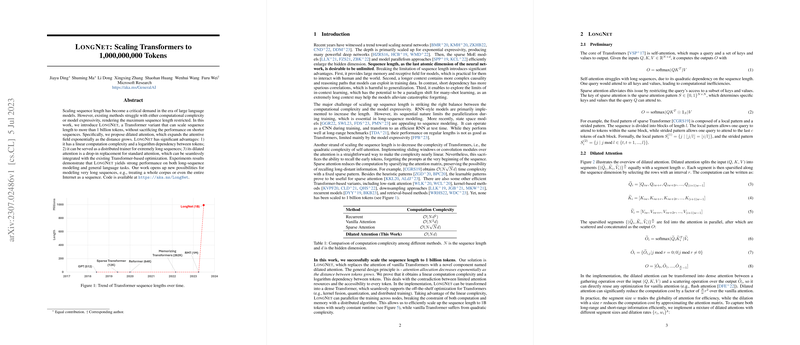Overview of LongNet: Scaling Transformers to 1 Billion Tokens
Recent advancements in Transformer models have significantly driven the evolution of natural language processing tasks, particularly in handling extensive sequences. The paper introduces LongNet, a novel variant of Transformer architectures designed to scale sequence length to an unprecedented 1 billion tokens. This development addresses critical challenges in managing computational complexity and model expressivity in long-sequence modeling.
Key Contributions
LongNet's chief contribution lies in its innovative dilated attention mechanism, which achieves linear computational complexity while maintaining a logarithmic dependency between any pair of tokens within a sequence. This attentional mechanism serves as a viable drop-in replacement for the standard attention mechanism, facilitating seamless integration with existing Transformer optimizations.
- Computational Efficiency: By introducing dilated attention, LongNet significantly reduces the computational complexity traditionally associated with Transformer models, notably from quadratic to linear. As shown in the complexity analysis, dilated attention maintains an efficient complexity compared to the quadratic complexity of standard Transformer self-attention.
- Distributed Training Paradigm: LongNet supports distributed training, allowing the parallelization of processing extremely long sequences across multiple GPUs. This approach overcomes the limitations imposed by both computational and memory constraints, effectively enabling the handling of sequences as long as 1 billion tokens.
- Integration Advantages: The dilated attention mechanism in LongNet is designed to be compatible with existing Transformer optimizations, such as kernel fusion, quantization, and distributed training strategies, making it a robust tool for practitioners and researchers looking to handle larger-scale sequence modeling tasks.
Numerical Results and Validation
Experiments conducted on LLMing tasks using LongNet reveal a notable improvement in performance over baseline Transformer and sparse Transformer models across various sequence lengths. When scaled up to a sequence length of 32K tokens, LongNet maintains superior perplexity metrics. The model's capacity to handle extended context windows during inference further underscores its potential over shorter sequence models, indicating a consistent scalability benefit.
Theoretical and Practical Implications
The theoretical implications of LongNet extend beyond immediate performance gains, offering insights into model behavior as sequence lengths grow. The efficient handling of long-range dependencies promises transformation in tasks requiring extensive contextual understanding, such as processing entire corpora or substantial portions of internet data.
Practically, LongNet paves the way for more resource-efficient and scalable models in large-scale computing environments. The reduction in computational costs enables more sustainable and broader applications of LLMs, especially in environments with constrained computational resources.
Speculation on Future Developments
The work on LongNet suggests several avenues for future research and application. As the adaptation of dilated attention is expanded to multimodal and genomic data, its potential to impact fields beyond traditional text processing becomes apparent. Furthermore, exploration into scaling models like BEiT pretrained architectures via LongNet could yield efficiency benefits in computer vision tasks. As such, future developments may focus on optimizing implementation details and further enhancing distributed training techniques to fully leverage the advantages offered by LongNet's scalability.
In conclusion, LongNet represents a substantial step forward in handling extensive sequence lengths within Transformer-based architectures. Its introduction of dilated attention not only enhances computational efficiency but also extends the applicability of Transformers to unprecedented sequence lengths, opening new possibilities for both theoretical exploration and practical implementation in advanced AI systems.
